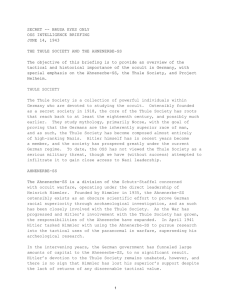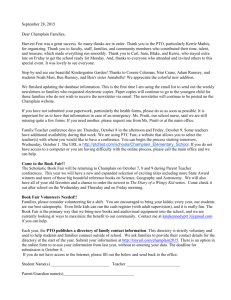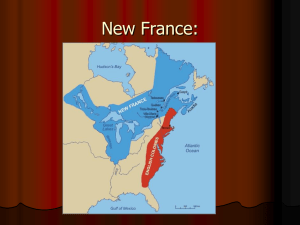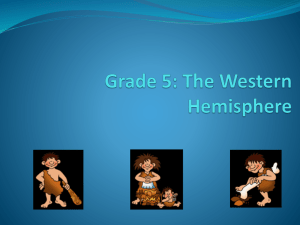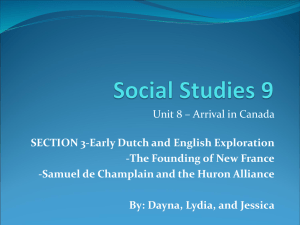Lecture
advertisement
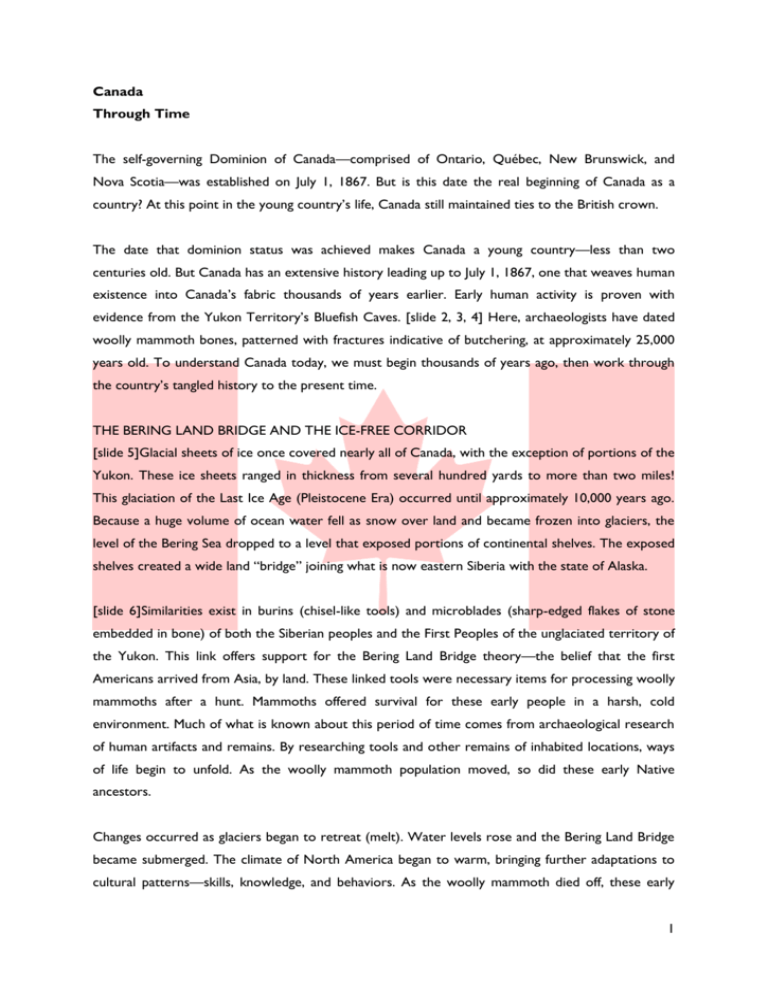
Canada Through Time The self-governing Dominion of Canada—comprised of Ontario, Québec, New Brunswick, and Nova Scotia—was established on July 1, 1867. But is this date the real beginning of Canada as a country? At this point in the young country’s life, Canada still maintained ties to the British crown. The date that dominion status was achieved makes Canada a young country—less than two centuries old. But Canada has an extensive history leading up to July 1, 1867, one that weaves human existence into Canada’s fabric thousands of years earlier. Early human activity is proven with evidence from the Yukon Territory’s Bluefish Caves. [slide 2, 3, 4] Here, archaeologists have dated woolly mammoth bones, patterned with fractures indicative of butchering, at approximately 25,000 years old. To understand Canada today, we must begin thousands of years ago, then work through the country’s tangled history to the present time. THE BERING LAND BRIDGE AND THE ICE-FREE CORRIDOR [slide 5]Glacial sheets of ice once covered nearly all of Canada, with the exception of portions of the Yukon. These ice sheets ranged in thickness from several hundred yards to more than two miles! This glaciation of the Last Ice Age (Pleistocene Era) occurred until approximately 10,000 years ago. Because a huge volume of ocean water fell as snow over land and became frozen into glaciers, the level of the Bering Sea dropped to a level that exposed portions of continental shelves. The exposed shelves created a wide land “bridge” joining what is now eastern Siberia with the state of Alaska. [slide 6]Similarities exist in burins (chisel-like tools) and microblades (sharp-edged flakes of stone embedded in bone) of both the Siberian peoples and the First Peoples of the unglaciated territory of the Yukon. This link offers support for the Bering Land Bridge theory—the belief that the first Americans arrived from Asia, by land. These linked tools were necessary items for processing woolly mammoths after a hunt. Mammoths offered survival for these early people in a harsh, cold environment. Much of what is known about this period of time comes from archaeological research of human artifacts and remains. By researching tools and other remains of inhabited locations, ways of life begin to unfold. As the woolly mammoth population moved, so did these early Native ancestors. Changes occurred as glaciers began to retreat (melt). Water levels rose and the Bering Land Bridge became submerged. The climate of North America began to warm, bringing further adaptations to cultural patterns—skills, knowledge, and behaviors. As the woolly mammoth died off, these early 1 humans adapted to changing environmental conditions. They began to hunt other large game and, eventually, whales and seals. Some scientists doubt the theory of early migrations by way of an ice-free corridor. They believe that conditions on land were too cold and harsh; in fact, some doubt whether an ice-free route ever even existed between the towering glaciers that covered the region. They offer another theory to explain how the first humans could have reached the Americas: that early peoples could have traveled along an open and much warmer water route, following the coast from Asia to North America. There is some evidence provided by artifacts discovered along the Pacific shores of Canada and the United States that offers at least some support for this idea. While the migratory route continues to be of scientific interest, it is of little importance to us. We know that Canada was settled tens of thousands of years ago. The earliest evidence of human presence in what is now Canada traces back only some 25,000 years. But some archaeologists believe that it may have been earlier, perhaps as long as 40,000 years ago. ABORIGINAL PEOPLES When eventual European exploration occurred, Canada was already populated by diverse groups of native people. Each geographic region presented its own set of environmental conditions to which early settlers adapted their lifestyles. The Native People were hunters, gatherers, fishers, and, later, farmers. Some lived settled lifestyles while others were nomadic, moving with the seasons and food sources. Although some people might incorrectly think of them as having been “primitive,” they had to possess a powerful knowledge of the land and its resources in order to survive. [slide 7]Of special note were the Huron. They lived along the southeastern corner of the Great Lake that now bears their name—Lake Huron. This location was a north–south trade crossroads. Here, linkages and networks of aboriginal North America crisscrossed. [slide 8]The Huron also dominated interior trade routes east to the Atlantic Ocean. An Iroquois-speaking population had a presence in the woodlands of this area as well. As European settlements spread westerly from the Atlantic Coast, native ways of life for all native peoples would be affected. THULE CULTURE: 9TH AND 10TH CENTURIES Inuit peoples (Eskimos) arrived in northern Canada perhaps 6,000 years ago. Approximately 1,000 years ago, a climatic warming occurred throughout the Arctic. [slide 9]The Thule, a whale-hunting people, took advantage of this development, traveling by umiak [slide 10](a boat with a skin-covered frame and several seats for passengers and supplies) through partially thawed waters. Migrating 2 whalers were equipped with sophisticated sea-hunting tools and techniques. Included were such items as detachable-head harpoons and multiple groupings of inflated sealskins used to slow harpooned whales. To the east and north, in Baffin Bay, waters were open and whale populations of the time were plentiful, encouraging exploration and the search for additional resources. [slide 11]Thule villages were located along northern coastal areas of Arctic Canada. Other natural resources, such as seal and caribou, sustained the Thule where whales were not plentiful or available; near Igloolik, on a small island west of Baffin Island, walrus offered a diversified hunting option. The Thule used bones from these animals as building materials, and their skins as roofs— creating what must have been a warm, smoky atmosphere in efficient dwellings. Within a period of a few hundred years, the Thule culture had spread throughout Arctic Canada. Subsequent climatic cooling, which began around 1200 A.D., may have begun the decline of the Thule way of life. Described as direct ancestors of the modern Inuit (meaning “the people” in the Inuktitut language), it is believed that the Thule people and their way of life became the Inuit culture of recent centuries. Inuit legends narrate the Thule migration and Arctic occupation, thus extending the history of the Thule culture. Culturally, there was a sharp division between the traditional Inuit (Eskimo) and First Nations (Indian) ways of life. EARLY EUROPEAN CONTACT: 10TH THROUGH 15TH CENTURIES During the period of the Thule movement east across Arctic Canada, a Viking [slide 12](Leif Ericson – is believed to be the first European to step in this territory called Vinland) [slide 13]settlement was being established in Newfoundland. [slide 14]This site, L’Anse aux Meadows, is the earliest known European settlement in North America. Excavations have unearthed the remains of timber and sod buildings, along with iron and bronze artifacts, which have been dated to 1000 A.D. According to Norse sagas (oral history), the Norse settlers fought against a native group the Vikings called “Scraelings” (it is not known which native population they represented). When relations between the Vikings and Scraelings turned hostile, the Vikings realized they were far outnumbered. They decided to abandon their settlement and return to Greenland, from which they initially had come. Nearly 500 years would pass before European exploration would once again continue in earnest. CONTINUED EUROPEAN ARRIVALS: 15TH AND 16TH CENTURIES [slide 15]The year was 1497. Italian navigator Giovanni Caboto was under orders from King Henry VII of England. Known in English as John Cabot, he was determined to find a new trade route (for the British Empire) to the Orient. What he rediscovered instead were the eastern shores of Canada, specifically Newfoundland and Labrador. He also discovered in the waters quantities of cod so thick that Cabot’s ship was slowed! When western Europeans learned of this resource, a thriving fishing 3 industry followed on what became known as Newfoundland’s Grand Banks. This was but the first of many instances in which Canada’s rich natural resources had an important impact on history. [slide 16]The British weren’t the only Europeans actively searching for the Northwest Passage. The much-sought-after passage, if found, would offer a shorter trade route from Europe to the vast wealth and valuable trade items of the Orient. Portuguese, Spanish, and French explorers were active in the quest as well. Though native populations in Canada were already established upon European arrival, explorers still claimed these lands in the New World as “theirs.” Soon, it would be the French who ventured into the waters surrounding Atlantic Canada. In a 1534 voyage, [slide 17]Frenchman Jacques Cartier located the inviting eastern water highway reaching into Canada’s interior. The St. Lawrence River promised blessings along its upstream route to the Great Lakes of inner Canada. With successive voyages in 1535 and shortly thereafter, Cartier established settlements that became present-day Québec City and Montréal. He had hoped to discover precious metals in the area to bring him wealth, but it was not to happen. Reports of luxurious furs worn by the native people, however, were welcome words to the ears of fashionable European hat makers. It was with this resource that elegant hats were designed from the velvety fur of the beaver. The French began sweeping through other portions of Canada. The rivers were inviting roads to parties of fur traders. By traveling these rivers, voyageurs (men hired by French fur companies) could transport supplies and goods to far-reaching posts throughout Canada and to the south. The French established trapping routes, with knowledge gained from the native populations, to obtain rich resources of fur. They established trading posts where furs could be collected. Furs were also obtained through trade with the native peoples. Small settlements were soon established to organize trade across much of the fur-supporting environment of North America. Furs from these smaller settlements would be gathered and transported by canoe to major settlements such as Montréal and Québec City before being shipped to Europe. COLONIZING EFFORTS: 17TH CENTURY [slide 18]A new century brought French navigator Samuel de Champlain to the St. Lawrence region of eastern Canada. From 1604 through 1609, Champlain undertook efforts to establish colonies to build New France. [slide 19]Champlain founded the first permanent French settlement, Québec City, in 1608. Champlain had three efforts in mind for colonization. First, he still wished to discover the elusive Northwest Passage. (An explorer named Jean Nicollet would still be searching for the Northwest 4 Passage in 1634. His search instead added Lake Michigan to European maps.) [slide 20]Additionally, Champlain had hopes for converting the Native populations from their traditional ways to the ways of Roman Catholicism. Champlain hoped that passing on the strong Catholic influence would be accomplished by missionary work with the Native People. However, the Native People already had their own strong beliefs and did not always welcome the efforts of the missionaries. As a third effort, Champlain wanted to further develop fur trade with the native populations. The expanse of Champlain’s dream of a fur-trading empire would come true beyond his imagination! French explorers, trappers, and traders journeyed west across the Canadian prairies, paddled north to Hudson Bay, and ventured south to the Gulf of Mexico. The legacy of these French trappers continues today in the hundreds of French place names that dot the linguistic landscape across much of the United States and Canada. The success of Champlain’s efforts depended greatly on establishing positive relationships with native peoples already living there. Champlain did this by exploring much of the provinces known today as Québec and Ontario on foot and by canoe. Often, native guides, sharing their impressive knowledge of the land, accompanied him. Strong trading partnerships were formed with natives. The Huron, a powerful nation of hunters, farmers, and traders, were included in these ties. Not to be forgotten, the British were sending Henry Hudson across the Atlantic Ocean. He located a bay that is named for him, Hudson Bay, in 1610. The European powers of France and Britain were both coveting the domination of global trade. Both empires treasured “newly discovered” lands. France claimed central Canada, including much of present-day Ontario. The British, in Hudson Bay, also lay claim to much of the same land. It was inevitable that, in time, the conflicts of these interests would escalate. 5

